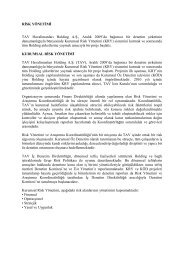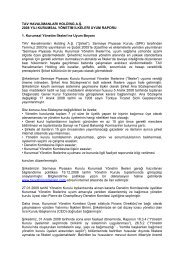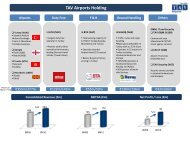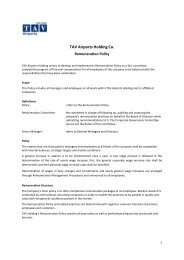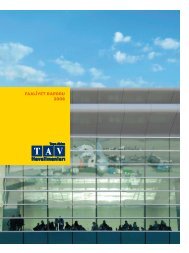TAV IT
TAV IT
TAV IT
You also want an ePaper? Increase the reach of your titles
YUMPU automatically turns print PDFs into web optimized ePapers that Google loves.
110<br />
<strong>TAV</strong> Airports Holding Annual Report 2008<br />
sustaınabılıty and the envıronment<br />
from solar energy stand out as suitable platforms, as facilities<br />
that can be used as test cases for the Company’s solar energy<br />
initiatives.<br />
With waste water treatment facilities installed at the airports<br />
and terminals it operates, <strong>TAV</strong> Airports employs practices such<br />
as returning treated water to sewage systems and using the<br />
treated water in irrigation. With a pilot project initiated at the<br />
Tbilisi International Airport, the Company prevents de-icing<br />
fluid applied to the body and wing surfaces of the aircraft in the<br />
winter months from mixing into the sewage system by collecting<br />
it through channels other than rain water channels. This practice<br />
prevents negative environmental impacts.<br />
Furthermore, the Company is accelerating its efforts in replacing<br />
vehicles and construction equipment powered by diesel or<br />
gasoline fired internal combustion engines with electric vehicles<br />
and construction equipment. With these initiatives, <strong>TAV</strong><br />
Airports undoubtedly will be among the world’s pioneers in<br />
environmentally friendly airport operations.<br />
The Company has adopted the principle of taking into<br />
consideration not only the present day of the airports, but also<br />
the future generations that the airports will cater to, positioning<br />
itself among the pioneers in supporting the concept of green<br />
airports that is gaining momentum rapidly throughout the world.<br />
In short, <strong>TAV</strong> Airports is determined to expend its best efforts to<br />
pass on to future generations a fast and safe, as well as clean,<br />
mode of transportation.<br />
Environmentally Sensitive Project from <strong>TAV</strong> Istanbul<br />
Having acquired a “Self-Producer License” from the Energy<br />
Market Regulatory Authority (EPDK) in February 2008, <strong>TAV</strong><br />
Istanbul is implementing a “Trigeneration Project” in order to<br />
generate the electricity of the İstanbul Atatürk Airport. Once the<br />
project is completed, İstanbul Atatürk Airport will be generating<br />
its own electricity and air-conditioning energy.<br />
While generating electricity with this project, the heat recaptured<br />
will be used for terminal air-conditioning. These measures will<br />
provide a 25% savings in energy costs. Expected to have an<br />
installed capacity of 9.9 MW, the plant will generate 100% of the<br />
Airport’s electricity consumption, as well as 40% of its heating<br />
and 35% of its cooling needs. As a result, Atatürk Airport will<br />
have lower costs and more efficient energy usage.<br />
<strong>TAV</strong> Esenboga: First Airport to Produce its Own Energy<br />
<strong>TAV</strong> Esenboga broke new ground at the Ankara Esenboğa<br />
Airport with the Cogeneration Project that allows the facility to<br />
generate its own electricity. For the first time in Turkey, an airport<br />
began generating its own electricity and reduced its energy<br />
consumption by 25%.<br />
At Esenboğa Airport, where the Company launched an integrated<br />
electricity heat plant as part of its Cogeneration Project, the<br />
Company generates electricity from natural gas and has reduced<br />
its energy costs by 25% by using recaptured heat in terminal<br />
air-conditioning. Thanks to this project, <strong>TAV</strong> Esenboga has been<br />
using cheaper and safer electric energy.<br />
The Cogeneration Project is being cited as an example by the<br />
Turkish State Airports Authority (DHMİ) as a model to be used in<br />
other airports.<br />
Environmentally Friendly Airport<br />
All <strong>TAV</strong> Esenboga projects adhere to the principle of minimizing<br />
emissions of carbon dioxide (CO 2<br />
), a greenhouse gas, and carbon<br />
monoxide (CO), a poisonous gas that causes air pollution, in<br />
an attempt to improve air quality and protect against global<br />
warming.<br />
In line with this principle, the Esenboğa Airport Domestic-<br />
International Terminal Building and Components Project stands<br />
out with its environmentally friendly credentials. The project<br />
distinguishes itself through the utilization of natural resources<br />
and recycling management, energy management systems and<br />
extensive green area planning.<br />
Energy Management at Esenboğa<br />
Using mechanical and electrical automation systems, terminal<br />
building lighting and inside temperatures are adjusted<br />
automatically at the Ankara Esenboğa Airport, and escalators<br />
operate only when they are being used. As a result, redundant<br />
energy use is avoided and energy conservation of up to 20% is<br />
achieved, compared to a building that is not equipped with this<br />
system. The 20% energy conservation at the facility corresponds<br />
to 5,706,421 kWh/year.<br />
Saved CO 2<br />
emissions as a result of energy conservation:<br />
5,135,779 kg/year<br />
Saved CO emissions as a result of energy conservation: 233,445<br />
kg/year








